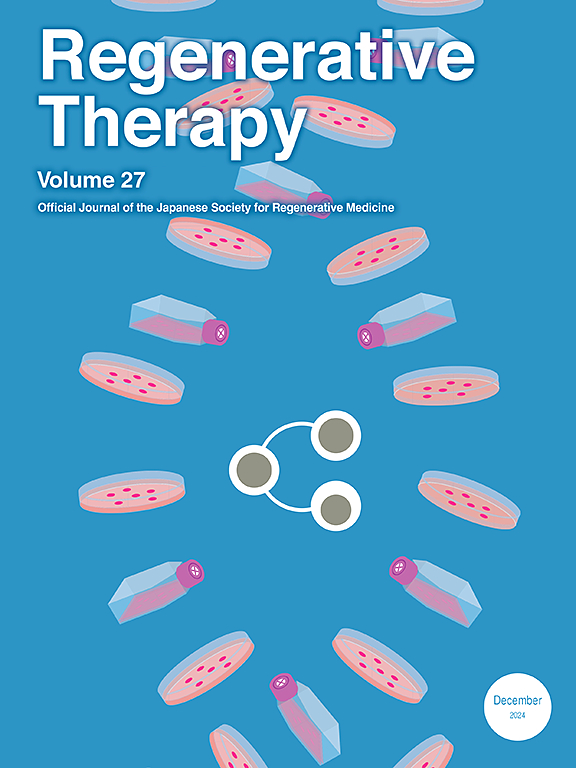重组犬玻璃体连接蛋白优化犬诱导多能干细胞培养
IF 3.5
3区 环境科学与生态学
Q3 CELL & TISSUE ENGINEERING
引用次数: 0
摘要
犬诱导多能干细胞(ciPSCs)作为兽医再生医学和疾病建模的重要工具而备受关注。使用iMatrix-511对ciPSCs进行无饲养培养已经成为可能。由于细胞外基质(ECM)的选择不仅会显著影响多能性的维持,还会影响定向分化的效率,因此对多种ECM底物的系统评估在ciPSC培养中也被认为是重要的。此外,考虑到未来的临床应用,建立无异种培养体系是必要的。Vitronectin (VTN)是一种易于在大肠杆菌中表达的重组蛋白,适用于规模化ECM生产。在这项研究中,我们生成了重组犬源性VTN,并与人源性ECM底物比较,评估了其对ciPSCs的影响。方法利用细菌表达系统,构建了犬玻璃体连接蛋白(cVTN和cVTN- n)的全长和n端截短重组蛋白。这些底物,连同已建立的人源ECM蛋白,包括iMatrix-511、hVTN和hVTN- n,被评估其支持ciPSC粘附、增殖、维持多能性和分化潜力的能力。通过免疫染色和基因表达分析评估多能性和分化能力。结果cVTN和cVTN- n均显示支持ciPSC附着和长期增殖,其水平与人源ECM底物相当。在cVTN或cVTN- n上培养的ciPSCs保持了高水平的多能性标志物的表达;其中,cVTN显著增强SOX2表达,而cVTN- n与中胚层标志物表达降低相关。在所有测试的底物上都实现了高效的EBs形成和三龄分化,各组间谱系标记的表达只有微小差异。结论重组犬源性VTN是一种有效的、物种匹配的ciPSC培养底物,表现出与人源性ECM蛋白相当的性能。这些结果表明,犬源性VTN能够在ciPSCs中稳定增殖并维持多能性,为犬再生医学的未来研究提供了一个有希望的平台。本文章由计算机程序翻译,如有差异,请以英文原文为准。
Recombinant production of canine vitronectin for optimizing the culture of canine induced pluripotent stem cells
Introduction
Canine induced pluripotent stem cells (ciPSCs) have attracted attention as valuable tools in veterinary regenerative medicine and disease modeling. Feeder-free culture of ciPSCs using iMatrix-511 has become feasible. Since the choice of extracellular matrix (ECM) has been shown to significantly affect not only the maintenance of pluripotency but also the efficiency of directed differentiation, systematic evaluation of multiple ECM substrates is considered important in ciPSC culture as well. Furthermore, considering future clinical applications, it is essential to establish a xeno-free culture system. Vitronectin (VTN) is a protein that can be easily expressed as a recombinant product in Escherichia coli, making it suitable for scalable ECM production. In this study, we generated recombinant canine-derived VTN and evaluated its effects on ciPSCs in comparison with human-derived ECM substrates.
Methods
In this study, we generated recombinant full-length and N-terminally truncated forms of canine vitronectin (cVTN and cVTN-N) using a bacterial expression system. These substrates, along with established human-derived ECM proteins including iMatrix-511, hVTN, and hVTN-N, were evaluated for their ability to support ciPSC adhesion, proliferation, and the maintenance of pluripotency and differentiation potential. Pluripotency and differentiation capacity were assessed using immunostaining and gene expression analysis.
Results
Both cVTN and cVTN-N demonstrated support for ciPSC attachment and long-term proliferation at levels comparable to those of human-derived ECM substrates. ciPSCs cultured on cVTN or cVTN-N maintained high expression levels of pluripotency markers; in particular, cVTN significantly enhanced SOX2 expression, while cVTN-N was associated with reduced mesodermal marker expression. Efficient EBs formation and trilineage differentiation were achieved on all tested substrates, with only minor differences in lineage marker expression among groups.
Conclusions
Recombinant canine-derived VTN were shown to function as an effective, species-matched substrate for ciPSC culture, exhibiting comparable performance to human-derived ECM proteins. These results suggest that canine-derived VTN enables stable proliferation and maintenance of pluripotency in ciPSCs, providing a promising platform for future research in canine regenerative medicine.
求助全文
通过发布文献求助,成功后即可免费获取论文全文。
去求助
来源期刊

Regenerative Therapy
Engineering-Biomedical Engineering
CiteScore
6.00
自引率
2.30%
发文量
106
审稿时长
49 days
期刊介绍:
Regenerative Therapy is the official peer-reviewed online journal of the Japanese Society for Regenerative Medicine.
Regenerative Therapy is a multidisciplinary journal that publishes original articles and reviews of basic research, clinical translation, industrial development, and regulatory issues focusing on stem cell biology, tissue engineering, and regenerative medicine.
 求助内容:
求助内容: 应助结果提醒方式:
应助结果提醒方式:


